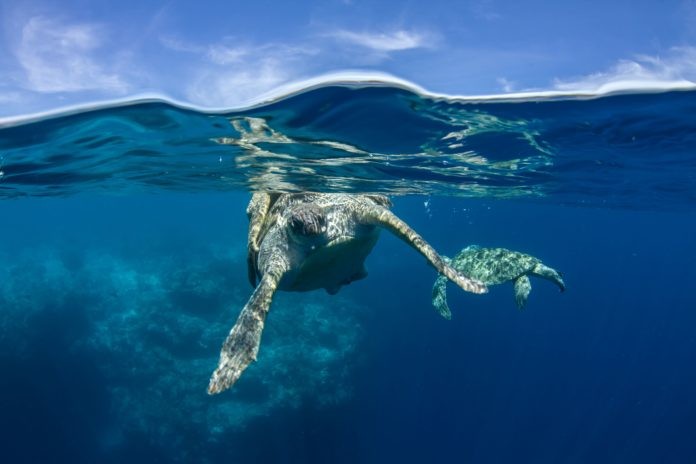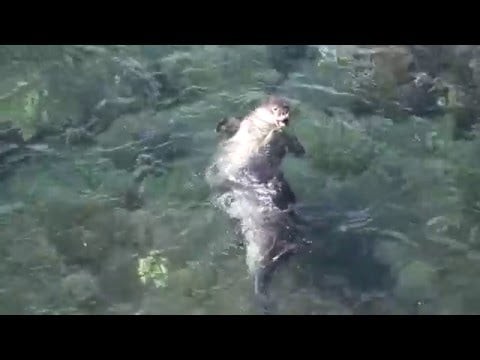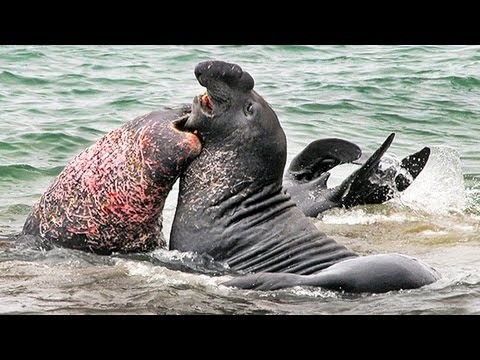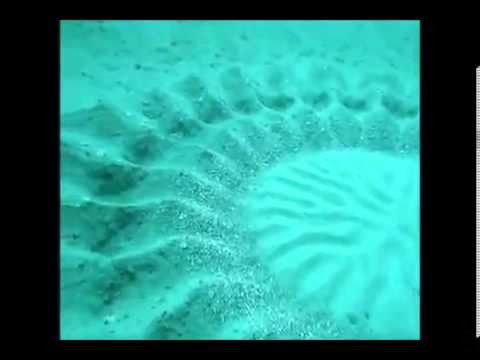As divers we routinely see the day-to-day life under the sea, the cleaning stations on the reef, the feeding, and the spats of territorial behaviour. Sometimes, if we are lucky, we get front row seats at the big undersea events — the spawning of the coral, and the congregating of the whale sharks.
Every now and then, we see a landmark event in the life of an individual ocean creature and we remember it particularly. We know we have witnessed something special, something rare, something we were lucky to come across in the huge expanse of water, when just for once we were in the right place at the right time and we looked the right way.
In this increasingly GoPro-filmed world, records are emerging of the secret life of the sea, the matings and the courtships of the big pelagics. Matings are fascinating but witnessing them is not without its risks.
Turtles
Male sea turtles are notoriously indiscriminate in their mating behaviour and they will try it on with anything that looks even vaguely turtle-like. Ancient seafaring nations in Polynesian and the Caribbean found catching male sea turtles ridiculously easy when they used wooden decoys or large flat leaves to entice the males because, once engaged, a male turtle is loath to let go.
Despite their laid-back, loveable image, sea turtles are sexually aggressive. Females observed on nesting beaches often have deeply scratched shells and bleeding wounds. These are caused by the hooks on the male’s front flippers which anchor onto their shells during mating.
Mating takes place either on the surface or under water, with several males often competing for the females who are outnumbered two to one. Female sea turtles will mate with several males before they head for the nesting beaches, storing the sperm so that when they finally nest, the eggs will have been fertilised by more than one male.
April to July is the mating season in the northern hemisphere and each season, where the turtles exist close to heavily populated areas, there are reports of male sea turtles either aggressively approaching or in some cases, trying to mount, divers. One report from 1989 tells of a turtle mounting a male scuba diver and “made good its mating attack on this luckless individual” (Epstein 1989) whilst attempting to pin the victim to the bottom.
If you do want to watch turtles mating – and on a good day it can be beautiful and graceful and it is certainly an amazing thing to see – then diving close to the areas where they come ashore to nest gives you a better chance. I know that Punta Sur off the south point of Isla Mujeres near Cancun is a veritable turtle love-in during May.
A bit of an aquatic dance initiates turtle mating behaviour. Males nip and bump and eventually mount the female. The male turtle hangs on to the front edge of the female’s shell with his retro-curved claws. The male’s tail has another “claw” at the end and this allows for a sturdy three-point attachment. He needs as good grip; turtle mating is tantric in the extreme and can take hours and hours, which may account for the stupid belief that turtle eggs are aphrodisiacs!
Dolphins
Flipper, despite his cheeky grin, has some very dubious sexual attitudes, not least of which is sexual bullying.
Whilst it is a joy to see dolphins in the wild those individuals that have no pod of their own or have spent a lot of time with humans can exhibit some confused behaviours.
Michael Maes, an underwater videographer based on Grand Cayman Island, posted a clip in 2012 of a dolphin called Stinky attempting to mount a diver. The YouTube clip shows Stinky pushing the human down to the bottom which, had the water been deeper, could have been fatal.
Writing on his YouTube page at the time, Maes said,
“It remains a wild animal and Stinky is in an awkward situation which can turn him into a playful killer-machine. Please be prudent people and get out of the water when you see him. Believe me, if he decides, you don’t stand the slightest chance!”
Dolphin mating is an all-year thing but peaks in Spring and Autumn. Recreational divers have filmed matings off Mauritius in February and at Columbus Passage Grand Turk in May. Sometimes they have captured beautiful balletic, seemingly romantic, pairings between two dolphins but generally dolphin mating is a group activity. The males will fight each other as the female will mate with the strongest and most dominant. The fights rarely cause serious injury, being mainly shows of aggression with sound and use of the fluke to demonstrate their strength, but they can continue until the males are exhausted.
You may get lucky and witness something spiritual if you get to see dolphins mating, but don’t be surprised if it is more like the orgy room at Burning Man.
Seals
I have a soft spot for seals, particularly the rare and solitary monk seals that I used to dive with in Turkey. Monk seals mate in the water and whilst a diver would be very lucky indeed to witness it you may be more likely to hear it as their strange ululating calls travel a long distance underwater. I did once see a male monk seal sliding through the shadows in joyous pursuit of a female but I never saw them do the deed; hopefully they did — we need all the monk seals we can get.
Hawaiian monk seals mate during a breeding season which runs between December and August. Females reach maturity at age four and bear one pup a year and with many more divers around the Hawaiian islands, a few have been photographed breeding and nurturing their pups.
Most seal species mate on land, allegedly. However, recent behavioural observations and DNA sampling seems to suggest that some elephant seals are mating at sea rather than on the beaches they were thought to favour.
Elephant seals are well known for their vicious fights and extensive harems. Giant males rule an area of beach where hundreds of just-pupped females wait to be impregnated. But who fathered the pups they have come ashore to have? It seems not the current Beachmaster because radio tracking has shown that the females arriving to give birth haven’t been ashore in over a year and yet they are pregnant. Somewhere out in the cold deep ocean things have been heating up! It has been suggested that the big harems presided over by loud males are actually a way for the females to have safety in numbers when they give birth onshore.
If you are crossing the blue water, far from land and you happen to spot a sea mating of elephant seals please photograph it — every marine biologist will buy you a drink.
Manta Rays
Hawaii, island of lurve, is a popular destination wedding for manta ray matings, as are the Maldives and the rather less romantic Galapagos. Manta mating is a dance, a love train of fluttering males pursuing a fast swimming female.
They mate twice a year in the Maldives, early winter and late spring, but in Japan they mate in the summer.
Manta mating is probably the most beautiful of the courtship rituals a diver can see and the safest to watch, being accessible even for novice divers. In Yap, Micronesia they regularly see trains of mating mantas between December and April and visiting divers are never less than overawed.
Whilst observing mating behaviours under the sea can be very special and memorable it can also be pretty dangerous. For turtles and dolphins mating is a full on riot and if you get in the way it’s going to get ugly.
A safer and no less impressive alternative is to witness the mating behaviour of a newly discovered variety of puffer fish off the coast of Japan. This romantic and resolute little fish uses tiny fins to create a complex pattern on the sea floor with which to impress a potential mate. Essentially he is sifting the sand to provide a perfect place for egg laying but the intricate circles are gorgeous and because the little puffer is only 12cm long he is unlikely to either fancy you, squash or drown you if you happen across his mating behaviour.







